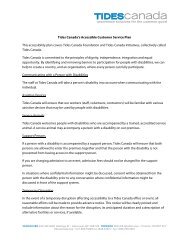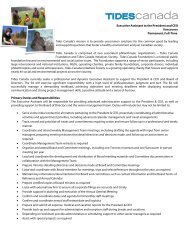Entrepreneurial Solutions to Insoluble Problems - Tides Canada
Entrepreneurial Solutions to Insoluble Problems - Tides Canada
Entrepreneurial Solutions to Insoluble Problems - Tides Canada
- No tags were found...
Create successful ePaper yourself
Turn your PDF publications into a flip-book with our unique Google optimized e-Paper software.
Growing OpportunityDeeper Dive: HealthAs companies considerthese markets, they havemuch <strong>to</strong> learn from socialentrepreneurs who havedeveloped successful crosssubsidizedbusiness modelsthat serve those whocan and cannot paysimultaneously.78www.ssireview.org/site/printer/vic<strong>to</strong>ria_haleOWH takes dormant intellectual property,owned by academia or companies inthe pharmaceutical and biotechnologyindustries, and develops it in<strong>to</strong> medicines<strong>to</strong> treat infectious disease in developingcountries. Its flagship project hassuccessfully taken paromomycin throughclinical trials as a treatment for VisceralLeishmaniasis. Partnering with the Indiangovernment has secured OWH a distributionagreement <strong>to</strong> guarantee the treatment’savailability for those who need it most —India’s rural poor. The company’stransparent and collaborative approach <strong>to</strong>drug development provides an intriguingmodel for traditional pharmaceuticalcompanies and their stakeholders <strong>to</strong>consider. Interestingly, following interestfrom inves<strong>to</strong>rs, the company is consideringthe potential of a for-profit approach. 78Emerging economies: smart solutionsUntil now, the priorities for the globalhealth community have been infectiousdiseases, and in particular, HIV/AIDS,malaria, and TB. Public-private partnerships,and much of the work of social entrepreneurs,have focused on these infectiousdiseases. However, disease profiles indeveloping countries are changing as aresult of urbanization, a more sedentarylifestyle, less physically demanding work,changing diets and an increase in smoking.Even among poorer communities, so-called‘diseases of the affluent’ — diabetes, cardiovasculardisease, cancer, and hypertension— are increasing at alarming rates.Many pharmaceutical and healthcarecompanies see the emerging marketsas important sources of future growth.For example, in 2006 cardiovasculardrugs already sold more than any othertherapeutic category in the Asia-Pacificmarket. But the complex interplay ofmedical need and capacity <strong>to</strong> pay posesignificant challenges. As companiesconsider these markets, they have much<strong>to</strong> learn from social entrepreneurs whohave developed successful cross-subsidizedbusiness models that serve those who canand cannot pay simultaneously. In addition,they can gain significant insight in<strong>to</strong>cultural and socio-economic fac<strong>to</strong>rs thatcontribute <strong>to</strong> successful operations inthese markets.35Consider the work of Vera Cordeiro inBrazil, who understands that the successof patient care is undermined by thesevere poverty in her country. Childrenoften leave the hospital and return <strong>to</strong>inadequate housing, poor nutrition, andother conditions that prevent them fromhealing. Her organization, AssociationSaúde Criança Renascer, is addressing thisproblem by providing post-hospitalizationassistance <strong>to</strong> the families of poor childrenrecently discharged from the hospital.The work of its network of volunteersmeans that at Hospital da Lagoa — a largepublic hospital in Rio de Janeiro, wherethe flagship Renascer is based — paediatricre-admissions have dropped by 60%.The Renascer model has proved easilytransferable and ideal for locations in whichdisease is exacerbated by socio-economicfac<strong>to</strong>rs. It has spread <strong>to</strong> an additional 17hospitals in Brazil and served more than26,000 people <strong>to</strong> date.Or take Laura Peterson, Executive Direc<strong>to</strong>rof Hands <strong>to</strong> Hearts International (HHI),a nascent operation in India that promotesearly childhood development. HHI combineseconomic development/empowerment fordisadvantaged women with desperatelyneeded health services for orphanedchildren. Their simple model is yieldingimpressive results. Further, HHI is learningimportant lessons about how <strong>to</strong> workeffectively in India. HHI goes beyond simplyimproving the conditions for the childrenin orphanages — HHI takes aim at the rootcauses, forwarding women’s access <strong>to</strong>education and economic empowerment.‘The world has come <strong>to</strong> recognize that thehealth of our world’s children is inextricablytied <strong>to</strong> the empowerment of our world'swomen,’ says Peterson. ‘Smart solutionsneed <strong>to</strong> address societal fac<strong>to</strong>rs <strong>to</strong> reachcore causes. By looking at issues in aholistic context, entire communities reaplong-term benefits and unpredictable andprofound health outcomes follow.’
















